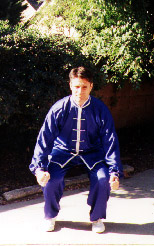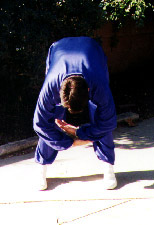|
7. Draw a Bow on Both Sides After the last repetition of the previous form, bring the hands down like closing T'ai Chi and store more energy in the Lower Dantian. Then raise arms upward (palms down) and face outward 45-60 degrees both directions. Then turn the torso right while turning right palm inward and the left palm outward. The inward palm stores fresh chi gathered on the Laogong (Hundred labors point located in the center of the palm) to be stored in the Chihu (Chi Door point located straight up from the mammary gland [nipple] and located below the collar bones on both sides of the upper chest. The outward palm reaches beyond (Don't use force to stretch) and gathers outer realm (or, universal) chi for storage in the Lower Dantian.

This form is great for gathering energy both worked for in front of you, and that which lays beyond the practitioners physical realm. The turning of the torso activates the Dai (belt) meridian, which stimulates all 12 channels. This form also helps strengthen the lower back and hips.
|
8. Circle Legs In three sub parts as follows:
a. After the previous form, bring the hands down to the sides of the body, place hands on hips, and move weight into right leg. First, circle the left leg slowly by raising the leg up and bringing it inward. Repeating for a total of four repetitions. Then reverse directions for four repetitions. Second, switch legs and repeat both directions but swing the right leg.
b. Then sweep the leg. Beginning with the left leg first sweep outward for four repetitions, and reverse sweeping inward for four repetitions. Then switch legs and repeat. Try to extend the leg far, and close to the surface of the ground. Circle slowly.
c. Then swing the leg like a single lotus kick. Starting with the left leg and swinging outward for four repetitions, and reversing for four repetitions. Then switch legs and repeat.
(See the three pictures in the above section.)
This form is especially good for developing the Kua (Hip), which is an important point in internal arts practice. In fact, T'ai Chi and Chi Kung on the advanced level are further enhanced by hips that can droop (further sinking the chi) without bending the legs. This dropping of the buttocks is achieved by developing strong, flexible hips which this exercise is known for. The Yongchuan gathers both Yin and Yang energies during circling, and the standing leg becomes stronger through practice. This form also helps to relieve any pressure built-up along the sciatica nerve, and further helps open the Huantiao point (located in the center of the hips, and most sensitive place to contact the sciatica nerve through acupressure).
Additionally, this form has three variations with the hands as follows: hands on hips, hands in the small of the back, and arms folded in front of the chest. Each one of these variations challenges and strengthens the balance by placing a different form of pressure on various aspects of the connective tissue and multiple parts of the practitioner's body and wherewithal that effect balance.
|
|
9. Strike Opponents Ears with Both Fists First step forward onto the left leg, then raise fists up (knuckles pointed inward), and strike opponents ears. This is similar to the form practiced in the T'ai Chi Forms practice (Both Slow and Fast Forms), except after striking the opponents ears, gradually sit back in the hips, bring the fists down, turn them over, change into palms, and repeat for a total of four repetitions. Then step back with the left leg, switch legs, and repeat for four repetitions with the right leg forward.

This form is good for stimulating the Yin and Yang Channels on both hands. The bringing down of the fists also places additional stimulation on the Yin and Yang Channels of the Hands, and also stimulates the organs from the increased pressure on the fingers. The Laogong point is stimulated and chi is pumped naturally through the center of the palm while striking, and opening and closing of the palm throughout the exercise.

|
10. The Wizard Carries the Magical Clouds Step back with the right foot, and bring the hands down to the sides. Step forward with the left foot, and extend the right hand (at shoulder level) forward and the left hand backwards. Move slowly back and change hands. Finally, sit all the way back in the right leg, raise left toe, again the right hand extends forward. This is considered one repetition as briefly described here. The hands move in opposition with the legs as if walking in place. This is one of the most interesting of the 13 forms. Practice three more times for a total of four repetitions. Then switch legs and repeat on the other side of the body for four repetitions.

This form is good for reducing complications for a variety of ailments. The extending arms stimulate the Yang and Yin Channels of the hands. The palms up continually gather Yang energy, and each time fresh energy is poured into the Chihu (Chi Door) point located straight up from the mammary glands below the clavicles. The dynamics of the movements along with the turning of the waist stimulate chi on all channels. The rocking or moving back and forth stimulates the Yin and Yang Channels of the legs, the Yongchuan point (located in the center of the feet behind the balls of the feet. The toes rising up when sitting back, help to stretch the hamstrings and back of the knee. The sitting back helps encourage storage of energy in the Lower Dantian, and also helps to sink and stake energy through the Yongchuan of the rear foot. Probably the most interesting of all 13 forms of the Wu Style T'ai Chi Chi Kung.
|
|
11. The Wizard Parts the Magical Clouds a. Step back with the right foot into Wu Style's parallel stance. At the same time bring both hands to the front and down like closing T'ai Chi. Then interlace the thumbs (left inside right) and circle palms inward towards the body, up, lean back and gaze up through the palms to the sky. Continue circling upward and outward in front of you and down to the ground, come up and repeat for a total of four repetitions. Then reverse directions for four more repetitions.
b. Then circle laterally, by turning the torso left and circling in the left direction first for repetitions, and the reverse for four repetitions.

This form is good for the microcosmic orbit (pulmonary circulation), expanding the Mingmen's (Life Gate's) potential. Every time you arch the back when gazing upward be careful to do this very slow and gently, and this will help to develop the Mingmen and strengthen the back. Bending over helps strengthen the bladder and kidney channels. Bend knees slightly if you have chronic backache. Also don't bend over too far and allow the head to pass below the heart if you have high blood pressure or a heart problem. When you perform part b, and circle when turning laterally you will really feel it working the kidney and at times the Sciatica.
|
12. Pei Gong Picks Up, Puts Down, and Plays with the Stone with Great Ease a. Bring the hands down close to the sides of the head, the torso, and pass through the hips. Gradually squat, and from the hips form fists and extend out from the knees. Go down only as far as you can keep knee and toe alignment and the buttocks tucked in and yet dropped and relaxed. Then gradually stand up, and bring the hands up above the head. At the height of standing, stand on both balls of the feet. Repeat for a total of four repetitions, and then reverse for four more repetitions.

b. Then turn the torso left and do the same exercise laterally for four repetitions total, and then reverse.

This form is good for flowing the chi from top to bottom in all channels. The Mingmen (Life Gate) point if it can be opened correctly can help to gather a multitude of chi during the practice of this form. The Yongchuan also sticks deeper into the ground when squatting. The Laogong point and Yongchuan are both opened and closed to the maximum with correct practice. This form breaks a sweat among the strongest Chi Kung practitioners.
|
|
13. Stare Deep Into the Well, and Gather the Chi Bring the arms out to form a circular motion, and slowly bend at the waist. Bend over as far as you can (following advice given before about bending). At the bottom, embrace a ball in front of your torso (In front of Lower Dantian if possible) with the left arm on the inside. Then stand back up slowly, moving the arms out and up in a circular motion. Like in the form before at the height of standing up, stand up higher on the balls of the feet. After four repetitions, bring the hands down slowly, from the top above the head, like closing T'ai Chi. Stand balanced for some time. This concludes the 13 postures of Wu Style T'ai Chi Chi Kung.

This form is good for storing massive amounts of chi in the Lower Dantian. Bending over helps bring the chi down and the rounding of the arms all encourage a gathering, embracing, pouring, and storing of chi. Bending also encourages stimulation of the bladder and kidney channels, while chi is being stored in the Lower Dantian. The circling arms gather chi in all directions, and the projection of the upper limbs combined with the embracing while bending over encourage the practitioner to blend the external and internal chi together for storage and completion of practice.
|
Conclusion We try to make sure Chiflow.com offers some unique resources.
Click here to return to the first page in the Wu style Chi Kung article.
Click here to return to the chiflow home page.
Click here to go to the Wu Style Tai Chi origins page.


GO TO THE CHIFLOW.COM HOMEPAGE
|

















